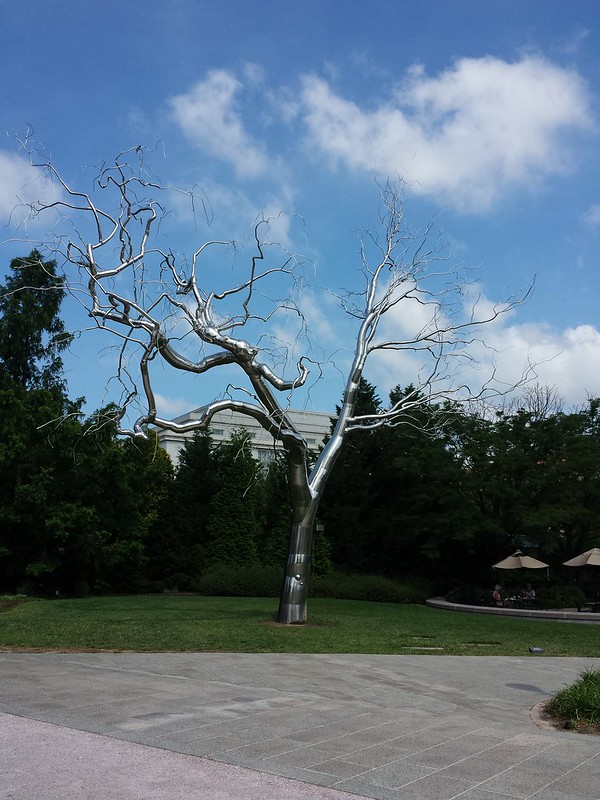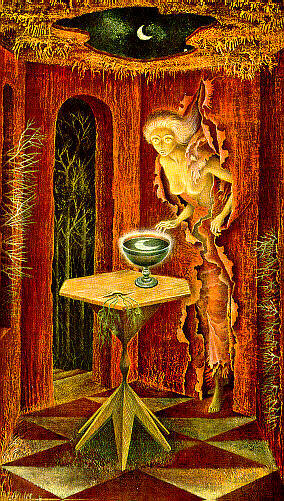
Question Mark, Minneapolis Sculpture Garden, Minneapolis, Minnesota, January 2008, all photos © 2008-2009 by QuoinMonkey. All rights reserved.
A few weeks ago, I watched an interview on Bill Moyers Journal and was mesmerized by the work of Anna Deavere Smith. It is tough work. She takes on controversial subjects most would not touch in our sanitized, politically correct language of the day. Her 1992 one-woman performance Fires in the Mirror explored the violence between Jews and Blacks after an August 1991 civic disturbance in the New York neighborhood of Crown Heights in Brooklyn. Her solo performance in Twilight: Los Angeles dramatized the 1992 riots that broke out in L.A. following the first Rodney King trial.
For her current one-woman play Let Me Down Easy, Anna Deavere Smith interviewed Americans from all walks of life about healthcare, medical, and end of life issues. After 9 years and 300 plus interviews, she chose 20 people; through their words, body language and speech, she transforms on stage into each one. I’ve only seen snippets of her 90 minute performance on TV. And from bullrider to politician to Buddhist monk, I could hear the voice of all America inserted into the healthcare debate, leaving little room for doubt — something has to change.
We are trying to bring disparate worlds together, not so that we can all get along, but so we can see out of the ‘me’ into ‘us.’
— Anna Deavere Smith
__________________________________________
Highlights
Below are few notes I jotted down while listening to her conversation with Bill Moyers. A few may seem cryptic, but will make more sense when you watch the interview:
- The title Let Me Down Easy came to her almost out of a dream. There are two songs with the name. Of the title, James H. Cone of the Union Theological Seminary said they are the words of a broken heart and can be interpreted as broken love. “Don’t do it harshly. Not too mean. Let it be easy.”
- Let Me Down Easy is a call about grace and kindness in a world that lacks that often — in a winner take all world.
- Death is the ultimate form of loss, the ultimate form of abandonment
- It broke her heart to know that we, with all of our money and technology, believe that we can afford to leave people so alone
- Are we afraid of being poor, afraid of losing, afraid of being sick? Is that why we distance ourselves from that reality all around us?
- She chose these 20 particular people because they are very connected to the life cycle – death and life
- The most important thing you can do is be with someone when they die
- Art comes in when the official language falls apart. When things fall apart, you can see more and you can even be part of indicating new ways that things can be put together.
What seems to be important to Anna Deavere Smith is the art of listening. And letting what she hears soak into each cell of her body. Words matter. People matter. She believes something she learned from her grandfather (who was also the inspiration for her method of theater) — if you say a word often enough, it becomes you. In a New York Times article Through 1 Woman, 20 Views of Life’s End she says, “I try to embody America by embodying its words.”
Near the end of the interview, Bill Moyers asked, “When did you begin to listen to people so acutely?” Anna said when she was young, she lived next to a woman who weighed 400 pounds. The neighbor would ask her to go to the store to buy her fatback and she’d love to sit on her porch and listen to her stories — that’s when she started really listening.
__________________________________________
Writing Topic — 3 Questions
How do we teach ourselves to listen? How do we get people to talk about what has meaning for them, moving beyond repetition or sound bites? In Anna’s words, “I say their words over and over. I listen and I wear the words.”
She said she also taught herself to listen by breaking up certain rhythmic speech patterns. She met a linguist at a cocktail party in 1979 who said she would give her 3 questions that were guaranteed to break the patterns and change the way people are expressing themselves:
Have you ever come close to death?
Have you ever been accused of something you didn’t do?
Do you know the circumstances of your birth?
 And that’s the inspiration for this Writing Topic — 3 Questions.
And that’s the inspiration for this Writing Topic — 3 Questions.
Choose one of the 3 questions above. Write it down at the top of your paper. Take out a fast writing pen and do a timed 15 minute Writing Practice.
Maybe 3 questions, combined with the wild mind of Writing Practice, will break patterns in our writing and lead us to listen more closely to our own voices.
__________________________________________
Epilogue
Anna Deavere Smith is on fire. In pursuit of her mission to translate art into social commentary about race, poverty, and injustice, she’s won two Obie Awards, been nominated for the Pulitzer Prize and two Tonys, and is a recipient of the prized MacArthur fellowship. (Not to mention her role in NBC’s The West Wing, as National Security Advisor Nancy McNally.) You can read more about Anna Deavere Smith at Bill Moyers Journal. Or watch the full interview with Anna Deavere Smith and Bill Moyers at this link.
In November, the Moth Storytelling Awards in New York honored her as their 2009 recipient at the Annual Moth Ball. The Wall Street Journal blog Speakeasy covered the event which was also attended by writer Garrison Keillor. On the subject of healthcare, the blog references a compelling verbal account from Keillor that night about his stroke in September. He had the stroke while on a massage table, eventually drove himself to the ER, and waited 15 minutes in line before he was able to tell anyone he was having a stroke. Read the full story at Speakeasy: Jonathan Ames, Garrison Keillor and Anna Deavere Smith Headline Annual Moth Ball.
In some ways the most effective politicians are the ones who have the best verbal clothes that they manipulate the best way. And there is a gap between that type of clothing and where people walk and where people live.
Whitman was doing another kind of work for the country at that time. Speaking a different song. And I think the politicians can sing to us but I respect, in a way, the limitation of their language. I mean I guess it’s a part of our culture that goes back as far as Jefferson, that they have to be so careful about what they say. My only desire would then be that we would find other places in our culture to work out our differences.
— Anna Deavere Smith from Bill Moyers Journal, November 2009
-posted on red Ravine, Sunday, November 29th, 2009
Read Full Post »


































